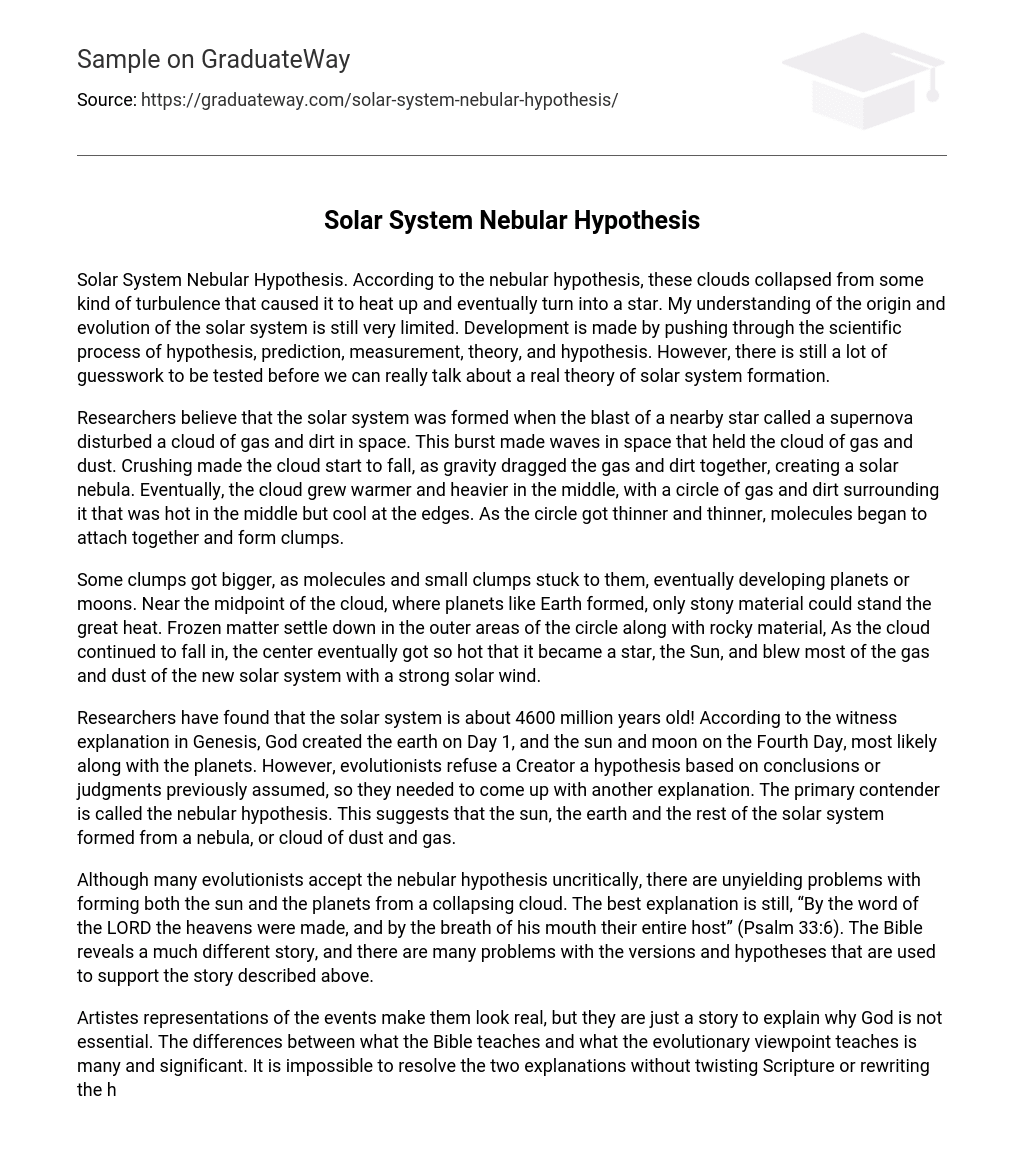The nebular hypothesis suggests that the collapse of clouds resulted in turbulence, which generated heat and led to the creation of a star. Nevertheless, my knowledge regarding the origin and evolution of the solar system is restricted. Advancements in this field depend on adhering to the scientific process: constructing hypotheses, making predictions, conducting measurements, formulating theories, and generating new hypotheses. Nonetheless, there is still a considerable amount of speculation that needs to be explored before we can establish a thorough theory concerning the formation of the solar system.
According to scientists, the solar system is believed to have formed when a nearby star exploded, which is known as a supernova. This explosion caused disturbances in a cloud of gas and dirt in space, creating ripples that surrounded the cloud. The compressions caused by these ripples led to the collapse of the cloud due to gravity, giving birth to a solar nebula. Gradually, the core of this nebula became hotter and denser, while cooler regions developed around it. Eventually, molecules began merging within the outer ring and forming clusters.
The process of planet and moon formation involves the aggregation of molecules and small clumps, with some clumps becoming larger over time. Specifically in the region where Earth-like planets were formed, only stony material could endure the extreme heat. Meanwhile, frozen matter and rocks settled in the outer parts of the cloud. As this cloud continued to collapse, its center became incredibly hot and eventually transformed into a star known as the Sun. The Sun then expelled much of the gas and dust in the new solar system through a forceful solar wind.
Scientists have discovered that the solar system is about 4,600 million years old. In contrast, according to Genesis, the earth was created by God on day one and possibly the sun, moon, and planets were formed on day four. Nonetheless, proponents of evolution dismiss the concept of a supreme being and suggest an alternative theory called the nebular hypothesis. This hypothesis suggests that our solar system’s sun, earth, and other elements originated from a cloud of dust and gas known as a nebula.
While some evolutionists accept the nebular hypothesis without question, there are still challenges in explaining how the sun and planets formed from a collapsing cloud. However, the Bible presents an alternative narrative stating that the heavens were created “by the word of the LORD” and “by the breath of his mouth” (Psalm 33:6). Additionally, there are several difficulties in interpreting and validating this biblical account.
The artist’s depictions of events may appear lifelike, but they are merely narratives that aim to justify the notion that God is not necessary. There are numerous and substantial disparities between the teachings of the Bible and the perspective of evolution. Merging these two explanations would require distorting Scripture or altering the historical accounts disclosed in Genesis. Meteorites encompass chondrules (glassy beads) and CAIs (calcium-aluminum inclusions).
Both calcium-aluminum-rich inclusions (CAIs) and chondrules underwent the processes of condensation, melting, and cooling prior to their consolidation through a medium composed of fine-grained dust particles. The formation of the solar system and the planets is conveyed through meteorites, which consist of a variety of elements. These elements depict the diverse array of materials and various physical and chemical environments that existed in the early solar system.
Reference
- Watanabe, Susan (July 20, 2001). “Mysteries of the Solar Nebula”. NASA. Retrieved 2007-04-02.
- He made the stars also interview with creationist astronomer Danny Faulkner, Creation 19(4):42–44, 1997. Return to text.
- “Dawn: A Journey to the Beginning of the Solar System”. Space Physics Center: UCLA. 2005. Retrieved 2007-11-03.
- Alfven, H. ; Arrhenius, G. (1976). “The Small Bodies”. SP-345 Evolution of the Solar System. NASA. Archived from the original on 13 May 2007. Retrieved 2007-04-12 5.
- Lang, Kenneth R. (2003). “Asteroids and meteorites”. NASA’s Cosmos. Retrieved 2007-04-02.





